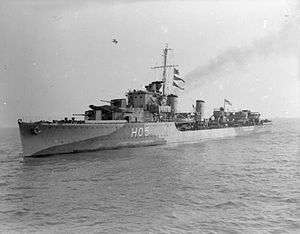HMS Ithuriel (H05)
 | |
| History | |
|---|---|
| Name: | HMS Ithuriel |
| Builder: | Vickers-Armstrongs |
| Laid down: | 24 May 1939 |
| Launched: | 15 December 1940 |
| Commissioned: | 3 March 1942 |
| Identification: | Pennant number: H05 |
| Fate: | Damaged beyond repair by enemy aircraft, 28 November 1942 |
| General characteristics (as built) | |
| Class and type: | I-class destroyer |
| Displacement: | |
| Length: | 323 ft (98.5 m) |
| Beam: | 33 ft (10.1 m) |
| Draught: | 12 ft 5 in (3.8 m) |
| Installed power: |
|
| Propulsion: | 2 shafts, 2 geared steam turbines |
| Speed: | 35.5 knots (65.7 km/h; 40.9 mph) |
| Range: | 5,530 nmi (10,240 km; 6,360 mi) at 15 knots (28 km/h; 17 mph) |
| Complement: | 145 |
| Sensors and processing systems: | ASDIC |
| Armament: |
|
| Service record | |
| Operations: | |
HMS Ithuriel was an I-class destroyer laid down for the Turkish Navy, but was purchased by the Royal Navy in 1939.
Description
Ithuriel displaced 1,370 long tons (1,390 t) at standard load and 1,918 long tons (1,949 t) at deep load. The ship had an overall length of 323 feet (98.5 m), a beam of 33 feet (10.1 m) and a draught of 12 feet 5 inches (3.8 m). She was powered by Parsons geared steam turbines, driving two shafts, which developed a total of 34,000 shaft horsepower (25,000 kW) and gave a maximum speed of 36 knots (67 km/h; 41 mph). Steam for the turbines was provided by three Admiralty three-drum boilers. Ithuriel carried a maximum of 470 long tons (480 t) of fuel oil that gave her a range of 5,530 nautical miles (10,240 km; 6,360 mi) at 15 knots (28 km/h; 17 mph). The ship's complement was 145 officers and men.[1]
The ship mounted four 4.7-inch (120 mm) Mark IX guns in single mounts. For anti-aircraft (AA) defence, Ithuriel had two quadruple Mark I mounts for the 0.5 inch Vickers Mark III machine gun. She was fitted with two above-water quintuple mounts for 21-inch (533 mm) torpedoes.[1] The ship was fitted with two depth charge throwers and two racks for 16 depth charges.[2]
Construction and career
Ithuriel was laid down as Gayret for the Turkish Navy by Vickers Armstrong at their Barrow-in-Furness shipyard on 24 May 1939, but taken over by the Royal Navy on the outbreak of the Second World War whilst still under construction. She was launched on 15 December 1940 and commissioned on 3 March 1942. In the Second World War, she took part in Operation Harpoon and Operation Pedestal, the escorting of convoys to Malta in June and August 1942.
Ithuriel was attacked by German aircraft at Bone in Algeria on night of 27–28 November 1942 and damaged beyond repair. On 29 November she was beached and temporary repairs were started. In January 1943 repairs proceeded enough to allow towing. On 27 February the destroyer was towed to Algiers for survey. In March Ithuriel was declared beyond local repair and laid up at Algiers.
In August, she was prepared for tow to Gibraltar. On 18 August, she sailed under tow from Algiers to Gibraltar. That September Ithuriel was placed in Care and maintenance for use at Gibraltar. In October, she was deployed at Gibraltar for accommodation and training duties.
In July 1944 the vessel was prepared for tow to the United Kingdom. On 1 August, Ithuriel began her passage to Plymouth under tow by the tug Prosperous. On 8 August, she was paid off on arrival at Plymouth. and placed on the Disposal List. The destroyer was sold to BISCO for demolition by P & W McLellan. On 11 August Ithuriel made her final voyage to Bo'ness, near Edinburgh. She arrived on 13 August at the breaker's yard. (Discrepancy in records as to whether sold for scrap in 1944 or 1945.)
Notes
References
- English, John (1993). Amazon to Ivanhoe: British Standard Destroyers of the 1930s. Kendal, England: World Ship Society. ISBN 0-905617-64-9.
- Friedman, Norman (2009). British Destroyers: From Earliest Days to the Second World War. Annapolis, Maryland: Naval Institute Press. ISBN 978-1-59114-081-8.
- Lenton, H. T. (1998). British & Empire Warships of the Second World War. Annapolis, Maryland: Naval Institute Press. ISBN 1-55750-048-7.
- Rohwer, Jürgen (2005). Chronology of the War at Sea 1939-1945: The Naval History of World War Two (Third Revised ed.). Annapolis, Maryland: Naval Institute Press. ISBN 1-59114-119-2.
- Whitley, M. J. (1988). Destroyers of World War Two: An International Encyclopedia. Annapolis, Maryland: Naval Institute Press. ISBN 0-87021-326-1.